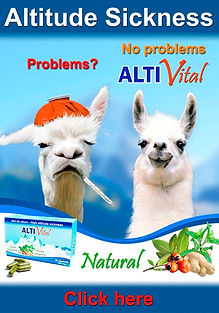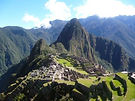PERU INFO
Home > About Peru > Flora > Coca
About Peru
Coca
Erythroxylum Coca
The coca leaf is found in the eastern side of the Andes (at the border of the Amazon Rainforest) of Peru, Chile, Bolivia, Ecuador and Colombia. It is cultivated in mountainous and humid regions between 300 and 1,500 meters above sea level (1,000 and 5,000 feet).
It is a bush which grows up to 1.5 m (5 feet) tall, with dark green leaves measuring 8 to 10 cm (3 to 4 inches) in length. They are oval and pointed on both ends, similar to a laurel. It has small white flower and ovoid red fruit.
History
Vestiges of coca use have been found as early as 3,000 bc in the Peruvian coast. "Coca" is the name that the Andean Indians gave this plant. It is very common in the Andean inhabitants. The chew the leaves (They call it chacchar or cullicar) to help with thirst, soothe hunger and tiredness.
The virtues of the coca leaf were approved by natural medicine (Monardes 1565, Hipólito Unanue - Lima 1794 Anad 1821, Pablo Mantegazza - Milan 1857 and 1859, Tomas Moreno and Maíz - París 1868, Sir Robert Christison - London 1876, Ulloa, Colunga and Ríos 1888, Golden W. Mortimer – New York 1901)
In 1859 Albert Niemann isolated its principal component and called it "cocaine". The coca leaf became famous in Europe from an essay by Paolo Mantegazza.
In 1863 the industrialization of the coca leave was begun in France with Mariani wines. In 1884 Sigmund Freud promoted its use and considered it as "the third scourge". In 1885, the American firm "Parke Davis & Company" distributed it in inhalers and cigarettes.
In 1886 "Coca Cola" was born, offered as a medicinal tonic. Then, important European laboratories commercialized in in a great variety of forms such as menthol pills, cocaine and borax for the throat that were given even to babies.
Prohibition
The "coqueo" (mastication), was identified as a "chronic intoxication" without experimental or clinical support by German psychiatrist Emil Kraepelin in 1899, reinforced by mass media to describing horror stories about drug addiction and cocaism and by Peruvian psychiatric Valdizán in 1913 and Gutierrez Noriega in 1944-1946.
In 1949 the "Commission of Enquiry on the Coca Leaf" from Units Nations defined "cocaism" as "habit of chewing coca leaves". Soon after, the "Expert Committee on Dependence-Producing Drugs" of the WHO considers "the Andean coqueo should be considered an addiction despite lack of some of its characteristics."
Since then, use of the coca leaf was prohibited worldwide, encouraging the illegal production and export of "Cocaine Hydrochloride" generating today US$500 million per year only in Peru. This prohibition ensures profitability of drug trafficking and soaring revenues diverted to other illegal businesses such as arms and other drugs trafficking, political, military, police and judges corruption.
Prohibited, but not for all
In 1961, the United Nations listed coca leaf on the list of prohibited substances and prohibited its use except for medical or scientific purposes, but with an exception: Stepan Company (Illinois - USA), the only commercial entity authorized to import coca leaves, primarily from Peru, about 100 tons per year. In this laboratory the alkaloid "cocaine" is isolated and then the cocaine-free leaves are sold to the Coca Cola Company. Stepan extracts 330 kg of cocaine each year and sells it to a pharmaceutical company, officially for medical purposes.
How to use
The Andean people chew dried leaves with a little piece of "llipt'a" (it looks like a small pebble) made of the ashes of plants like quinoa or kiwicha, allowing the effects of the alkaloids to be enhanced. After several minutes, an anesthetic effect is felt in the mouth. The leaves are not eaten, but rather spit out after 30 minutes.
Coca tea, or "mate de coca" is recommended for treating altitude sickness and is offered in all Andean hotels and restaurants.
Today one can find many different coca products, including candy, chocolate, drinks, etc.
Coca leaf properties
-
Anesthetic
-
Pain reliever
-
Stimulant
-
Soothing and sedating
-
Digestive
-
Eliminates fatigue
-
Improves blood circulation
-
Prevents cavities
Used in the following cases:
-
Altitude sickness
-
Gastritis
-
Ulcers
-
Hiccups
Coca leaf composition
The coca leaf is rich in minerals and vitamins, with high levels of nitrogen, calcium and carotene.
For natives in the area, the coca leaf was the only substantial source of calcium before the arrival of the Spanish conquistadors who brought cows and hens (milk and eggs) from Europe.
Analysis of Duke, Aulik and Plowman, Botanical Museum Leaflets 24 (6) - Harvard University 1975
COMPOSITION
g/100 g
Nitrogen
20.06
Carbohydrates
47.50
Fat
3.68
Protein
19.90
Energy
304 Kcal
VITAMINS
mg / 100g
Vitamin A
8.15
Vitamin C
10.50
Vitamin E
44.10
Vitamin B1 - Thiamin
0.73
Vitamin B2 - Riboflavin
0.88
Niacin
8.37
Beta carotene
9.40
Alfa carotene
2.76
MINERALS
mg / 100 g
Calcium
2097.62
Phosphorus
412.67
Iron
9.80
Potassium
1739.33
Magnesium
299.30
Sodium
39.40
Aluminium
17.39
MINERALS
mg / 100 g
Barium
6.18
Strontium
12.02
Boron
6.75
Copper
$1.22
Zinc
2.21
Manganese
9.15
Chromium
0.12
ALCALOIDS
PROPERTIES
Cocaine
Anesthetic and pain killer
Ecgonine
Metabolizes fats and glucose, carbohydrates, narrows blood vessels
Atropine
Anesthetic which produces dryness in the respiratory system
Pectin
Absorbent and antidiarrheal, together with vitamin E it regulates the production of melanin for the skin
Papain
A type of ferment which accelerates digestion
Hygrine
Stimulates the salivary glands when there is an oxygen deficiency in the environment
Gobulin
Regulates the lack of oxygen, improves blood circulation, prevents altitude sickness
Pyridine
Accelerates the formation and functioning of the brain, improves blood flow of the pituitary and the glands, helping the body to function better
Quinoline
Stops cavities from forming, joins phosphorus and calcium
Conine
Powerful anesthetic
Cocamine
Anesthetic which, together with quinolone, helps the cocaine to improves anesthetic and pain-relieving properties
Inulin
Refreshes and improves liver functioning, bile secretion and gallbladder accumulation
Benzoin
Improves the formation of muscular cells and prevents food petrification (useful for gastritis and ulcers)
Reserpine
Regulates blood pressure during hiccups and hypertension, and helps with the formation of bone cells
Peru




